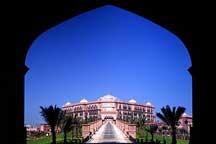 Apr. 10, 2025
Apr. 10, 2025
Weather
The Tajik ethnic minority
2009-08-07 11:40 BJTHistory
The origin of the Tajik ethnic group can be traced to tribes speaking eastern Iranian who had settled in the eastern part of the Pamirs more than twenty centuries ago. In the 11th century, the nomadic Turkic tribes called those people "Tajiks" who lived in Central Asia, spoke Iranian and believed in Islam. That is how "Tajik" came to be the name of the ethnic group inhabiting this area. So, the Tajik people who had lived in various areas of Xinjiang and those who had moved from the western Pamirs to settle in Taxkorgan at different times were ancestors of the present-day Tajik ethnic group in China.
The ancient tomb of Xiang Bao Bao, found through archaeological excavation in recent years in Taxkorgan, is a cultural relic ever discovered in the westernmost part of the country. Many burial objects found in this 3,000-year-old tomb and funeral rites they revealed show that the Tajik ethnic group has been a member of the big family of ethnic groups in China since ancient times.
In the late 18th century, Tsarist Russia took advantage of the turmoil in southern Xinjiang to occupy Ili and intensified its scheme to take control the Pamirs of China by repeatedly sending in "expeditions" to pave the way for armed expansion there. In 1895, Britain and Russia made a private deal to dismember the Pamirs and attempted to capture Puli. Together with the garrison troops, the Tajik people defended the border and fought for the territorial integrity of the country. At the same time, Tajik herdsmen volunteered to move to areas south of Puli, where they settled for land reclamation and animal husbandry while guarding the frontiers.
Social System Before 1949
The Tajik people were mainly engaged in animal husbandry and farming, but productivity was very low, unable to provide enough animal by-products in exchange for grain, tea, cloth and other necessities. The economic polarization resulting from heavy feudal oppression was best illustrated by the distribution of the means of production. The majority of the Tajik herdsmen owned very small herds, so that they were unable to maintain even the lowest standard of living, and still others had none at all. A small number of rich herdsmen not only owned numerous yaks, camels, horses and sheep, but held by force vast tracts of pasturage and fertile farmland.
In the Tajik areas, the chief means of exploitation used by rich herd owners was hiring laborers, who received only one sheep and one lamb as pay for tending 100 sheep over a period of six months. The pay for tending 200 sheep for the herd owner for one year was just the wool and milk from 20 ewes. Herd owners also extorted free service from poor herdsmen through the tradition of "mutual assistance within the clan."
Tajik peasants in Shache, Zepu, Yecheng and other farming areas were cruelly exploited by the landlords. In those areas, "gang farming" was a major way of exploitation. Besides paying rent in kind that took up two-thirds of their total output, tenants had to work without pay on plots managed by the landlords themselves every year, and even the peasants' wives and daughters had to work for the landlords. There was practically no difference between tenants and serfs except that the former had a bit of personal freedom.
There were all kinds of taxes and levies in both pastoral and rural areas. Especially during the 1947-1949 period, the Tajik herdsmen in Taxkorgan were forced to hand in more than 3,000 sheep and 500 tons of forage and firewood a year to the reactionary government. Poverty-stricken under heavy exploitation, the Tajik people were unable to make a decent living, and widespread diseases reduced their population to just about 7,000 when Xinjiang was liberated in December 1949.
Development after 1950
In 1954, the Taxkorgan Tajik Autonomous County was founded on the basis of the former Puli County where the Tajik ethnic group lived in compact communities.
At the time of China¡¯s national liberation in 1949, Taxkorgan had only 27,000 animals, two per capita of the total population in the county; total grain output was 850 tons, 55 kg per capita. Since 1959, the county has been self-sufficient in grain and fodder and able to deliver a large number of animals and quantities of furs and wool to the state each year. Several hundred hectares of new pasture and grassland have been added in recent years. There was no factory or workshop in Taxkorgan before 1949, and even horseshoes had to come from other places. Now more than 10 small factories and handicraft workshops have been built, such as farm and animal husbandry machine factories, hydroelectric power stations and fur processing mills. Mechanization of farming and animal husbandry has expanded. Veterinary stations have been built in most communities. Tajiks have been trained as veterinarians and agro-technicians. Tractors are being used in more than half of the land in the county. One breed of sheep developed by the Tajik herdsmen is among the best in Xinjiang.
Taxkorgan was a backward, out-of-the-way area before 1949, when it would take a fortnight by riding a camel or a week on horseback to reach Kashi, the biggest city in southern Xinjiang. In 1958, the Kashi-Taxkorgan Highway was completed, shortening the trip between the two places to one day.
In the town of Taxkorgan, the county seat, which is perched right on top of the Pamirs, wide streets link shops, the hospital, schools, the post office, bank, bookstore, meteorological station and other new buildings in traditional architectural style and factories under construction. Great changes have also taken place in many mountain hamlets, where shops and clinics have been built. The herdsmen and peasants are enjoying good health with the improvement of living conditions and medical care. Since 1959, schools have been set up in all villages, and roaming tent schools have been run for herdsmen's children. Many young Tajiks have been trained as workers, technicians, doctors and teachers.
The Tajik people's living standards have improved considerably with the steady growth of the local economy. A growing number of herdsman households have bought radios and TV sets.
Editor: Zhang Wen | Source: People's Daily Mail
Mail Share
Share Print
Print


 Video
Video









 2009 China Central Television. All Rights Reserved
2009 China Central Television. All Rights Reserved